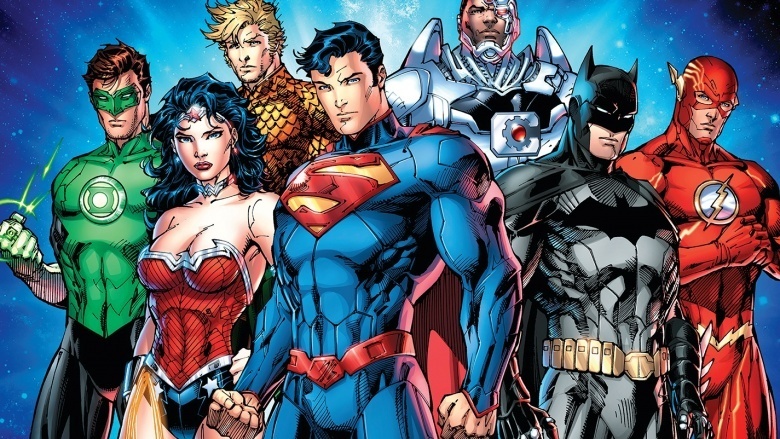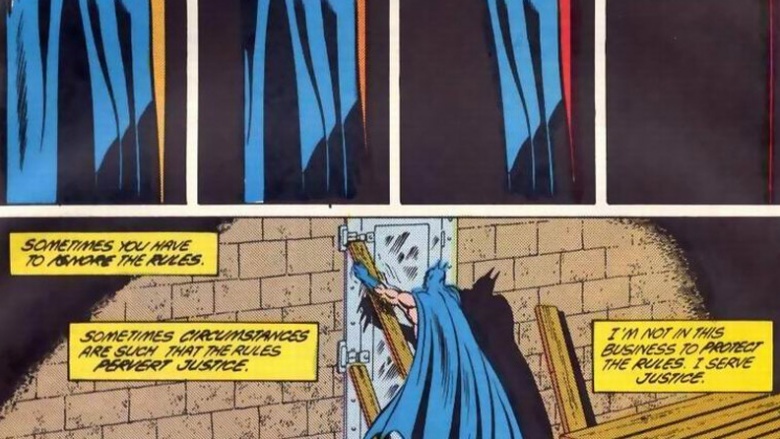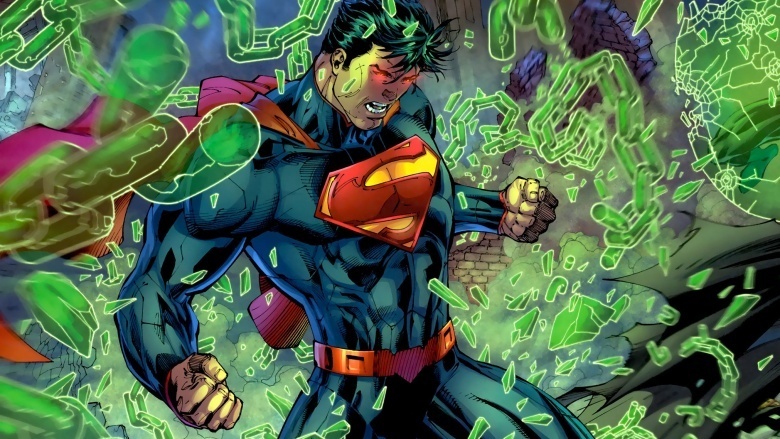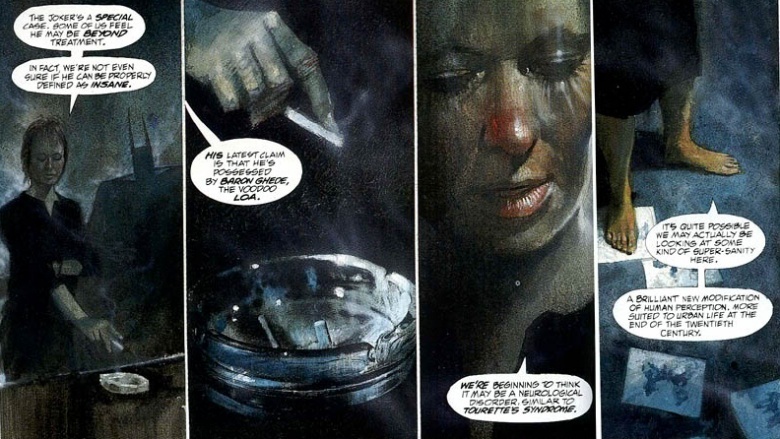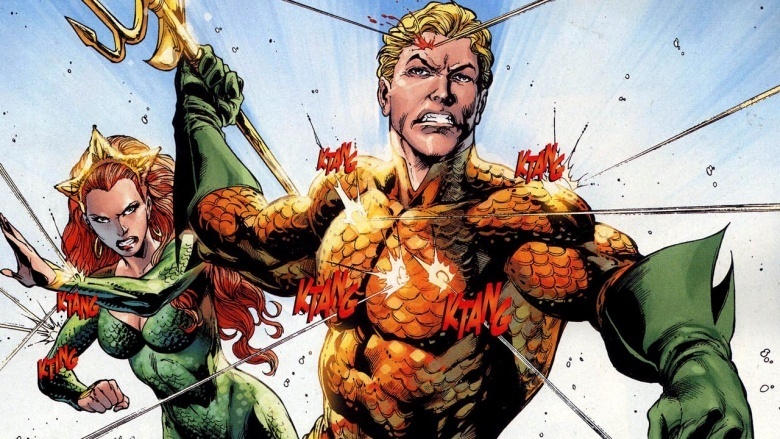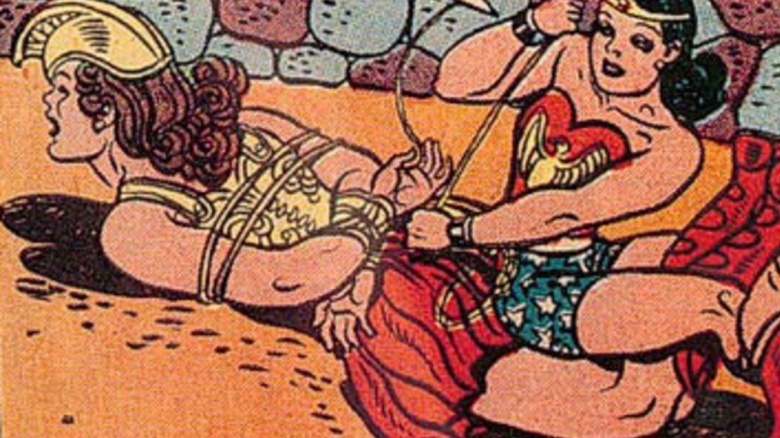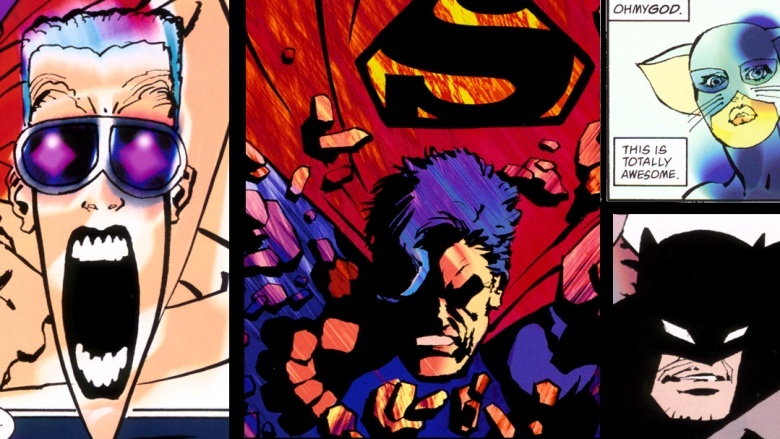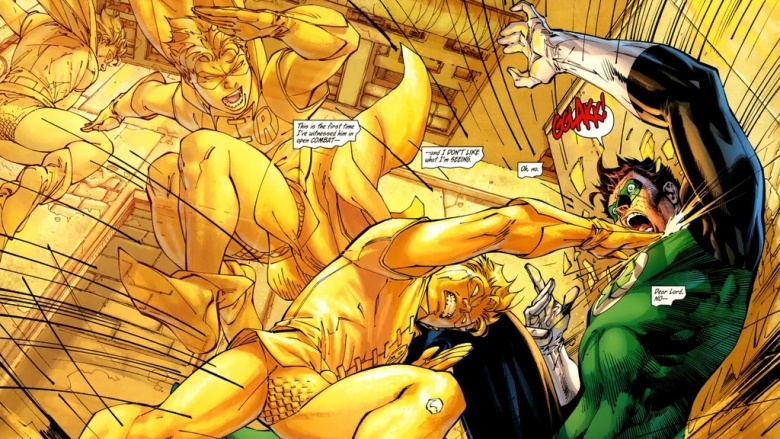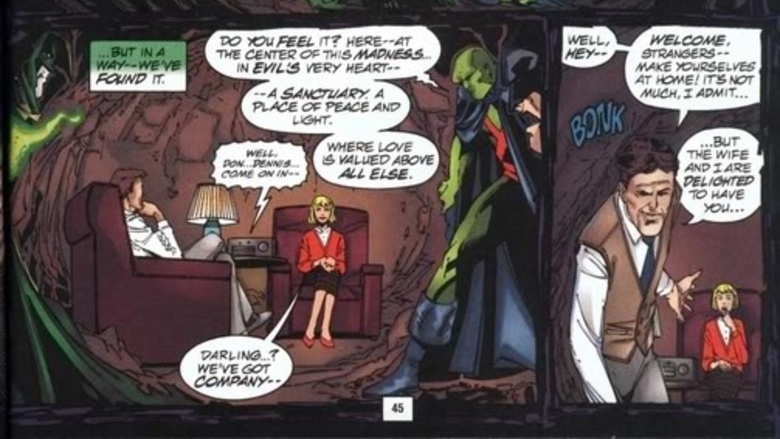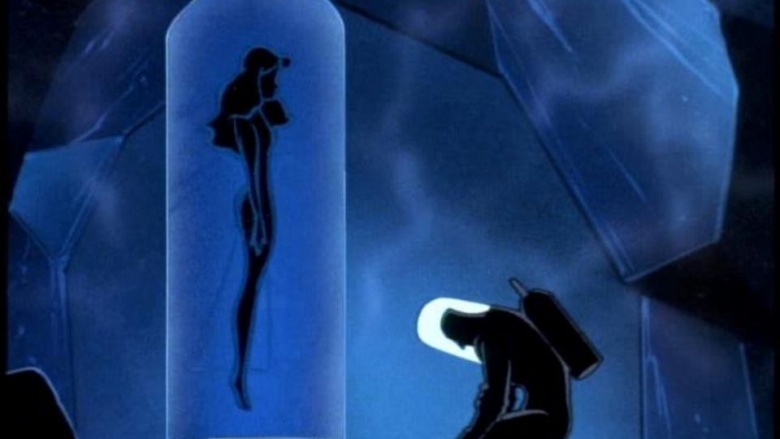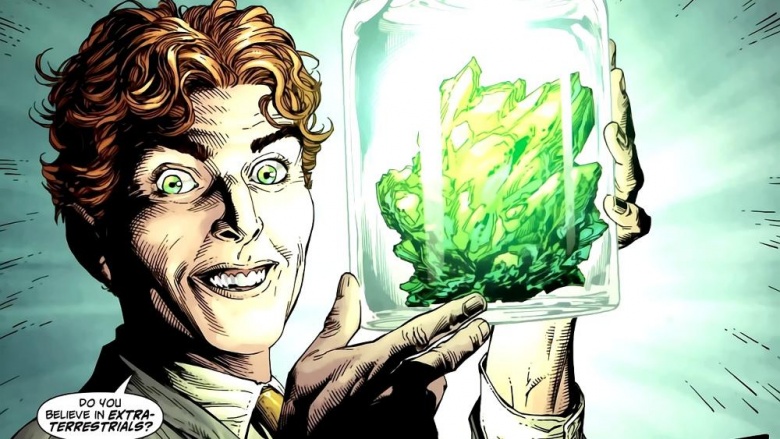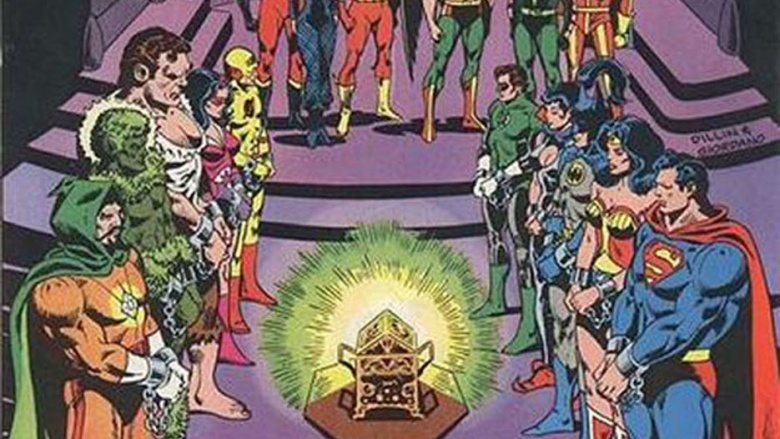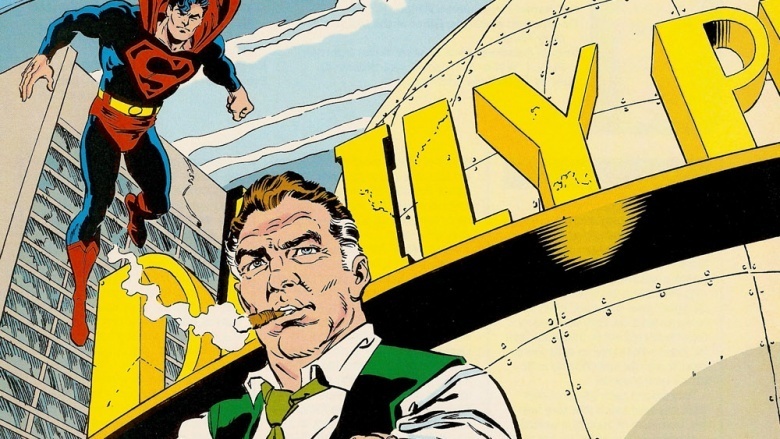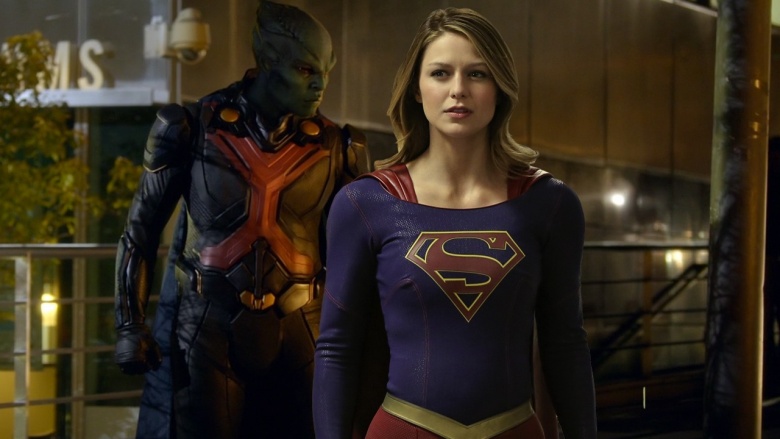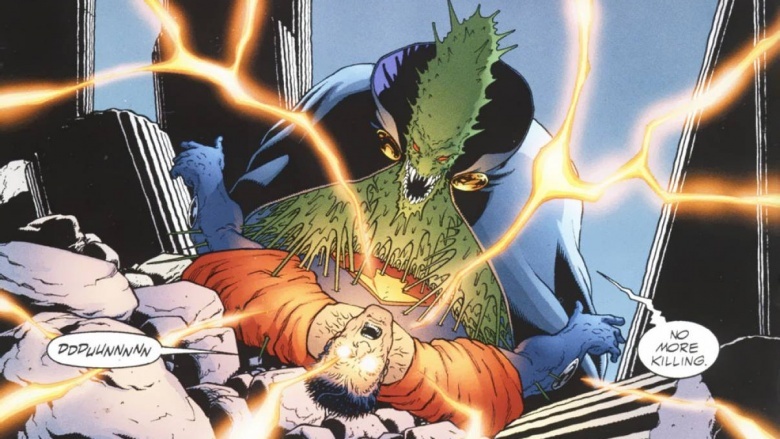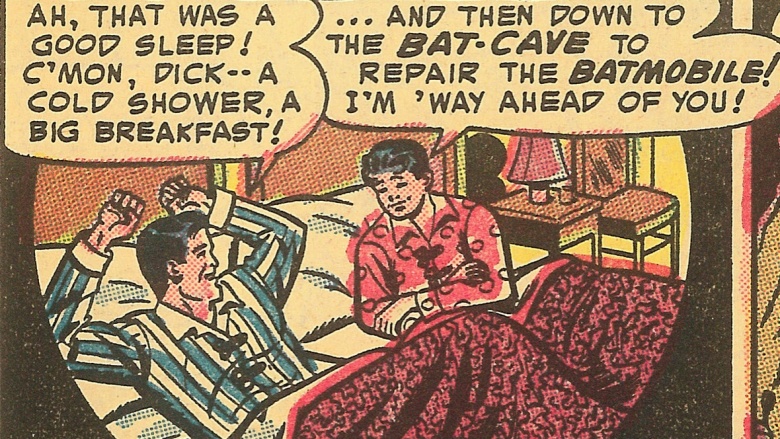False Facts About DC You Always Thought Were True
When it comes to DC comics, it's undeniable that there's an electricity in the air. Batman vs. Superman and Suicide Squad absolutely rocked the box office, while DC is enjoying positive sales and criticism for its recent Rebirth comic event. Hell, Netflix even confirmed they're bringing Young Justice back for a third season! With all of this DC love in the air, comes a ton of erroneous assumptions about our favorite heroes and villains. If you want to be the smartest nerd in the room, it's important to brush up on what's true and what's false about the DC Universe!
Batman never kills
A major part of Batman's characterization is his "one rule": he never kills anyone. This is, of course, an extreme reaction to the murder of his parents (not as extreme as dressing like a bat, of course), and it has formed the core of some of the best Batman stories in both the printed page and the silver screen. This includes The Dark Knight, in which the Joker is obsessed with making Batman break his "one rule."
However, the comics show us that this rule is more of a guideline, really. In some of Batman's earliest adventures, Batman was known to snap necks with a kick, push giant statues onto people, and even punch folks into acid. It's easy to write those off as times before the Batman character was really set in stone. Hell, go back far enough, and Batman had no problem using guns, either! But Bats has killed in modern times, too. For instance, when Batman fought the unfortunately named KGBeast, their fights were always to a standstill. Realizing he couldn't beat or capture him, Batman locked him into a room behind a steel door, reinforced the door, and just left the villain to rot. (This was retconned a few years later, but Batman definitely intended death.)
If that's not bad enough, Frank Miller's All-Star Batman and Robin featured a Batman who set a bunch of thugs on fire and then had sex with Black Canary right in front of their burning bodies. Kind of makes the kill-happy Batman of Batman vs. Superman seem tame, doesn't it?
Kryptonite has always been a part of Superman
It's easy to imagine that Kryptonite has always been a part of the Superman mythos. After all, it fits into that universe perfectly: since a hero is only as interesting as his vulnerabilities, it is a narrative necessity for the baddies to have something to level the playing field. However, just as Superman didn't begin his adventures by being able to fly (that "leaps tall buildings" thing used to be quite literal), he hasn't always been scared of green space rocks.
It didn't take Superman long to become a pop culture sensation. Within a few years of his comics debut, Superman enjoyed a wildly popular radio show. It was, in fact, so popular, the producers did not want to let the voice of Superman go on a much-needed vacation. But vacation he must so, in 1945, six years after his comics debut, the radio show unveiled Kryptonite as a substance that weakened our hero. The upshot for his tired voice actor? The Superman character just had to groan in pain for a few episodes, letting someone else fill in for him.
However, the idea of Kryptonite became popular enough that it finally made its way into Superman comics in 1949, and the rest is history.
The Joker's crazy
Most of us assume that the Joker is crazy because that's what most comic and movies tell us. We believe this in the face of what's often some interesting contrary evidence (Ledger's Joker jokes about not being a man with a plan, but his plans have a literal military precision — hardly the work of a chaotic and crazy criminal). However, the truth of the Joker not being crazy doesn't have to be extrapolated from his diabolical schemes. Instead, it is buried in comics history deep enough that most casual fans will never find it.
Comics legend Grant Morrison has redefined Superman, the Justice League, and many more amazing comics, but most of us found out about Grant Morrison when he wrote Arkham Asylum: A Serious House on Serious Earth. The book came out in 1989 and involved Batman being locked in the dreamlike asylum world of his various villains. In that book, one of the psychologists acknowledges that Joker isn't crazy: instead, he has a kind of "super-sanity," in which his powerful perceptive skills are mixed with the absence of his own persona. The result is that he is a reflection of the stimuli around him, often appearing crazy, but that craziness masks an adaptive skill that makes him uniquely suited for life in the 21st century.
When Morrison was the main Batman writer years later, he returned to this as a way of explaining why the Joker is often so different. Sometimes, he's a harmless clown (think Cesar Romero on the old Adam West Batman show), and other times a lethal killer (the man who crippled Barbara Gordon, took photos of her naked body, and possibly raped her).
Joker and Harley are in love
Another Joker-related falsehood is that the Joker and Harley Quinn are truly, madly, deeply in love. Fans of the power couple like to refer to the classic Paul Dini Batman story "Mad Love," as well as the assorted marketing for the Suicide Squad movie. This marketing included featuring romantic shots of the two from the movie, along with the hashtag #squadgoals.
What's the problem with this? Simply: Joker canonically does not love Harley Quinn: he's actually an abusive manipulator. "Mad Love" and those other comics and cartoons you remember? They always emphasized a Harley Quinn who was in love with a man who alternated between ignoring her, and abusing her. As for Suicide Squad, that movie had more edits than Hot Topic has Harley shirts, and earlier versions of the movie emphasized more of the Joker abusing Harley — including pushing her out of a helicopter in order to murder her. Due to weird editing choices that helped make the movie such a critical darling, the final cut makes it seem like Joker pushes her out to save her life.
It turns out that, while Joker may not love Harley, Warner Bros. certainly does—or at least, they love the chance to sell countless #squadgoals shirts to emo teenagers who want to stand out from the crowd by wearing the exact same thing as everyone else. And they call Joker crazy!
Aquaman is a joke
There are a vanishing number of constants in the world of comics fandom. Fans used to think they'd seen the last of characters like Jason Todd and Bucky Barnes, and then they come back as beloved new characters. One constant hasn't gone anywhere, though: seemingly everyone thinks Aquaman is a joke.
Part of the problem is that most people never read Aquaman comics. If they see the character at all, it's alongside the Justice League. Compared to people who can play volleyball with moons (Superman, Wonder Woman) and people who have ultimate authority over time and space (Flash, Green Lantern), the ability to talk to fish DOES seem less than impressive.
Here's the thing, though: Aquaman can do a whole lot more. In fact, he's a bit of a badass. First off, fish telepathy is cooler than you might think. He can essentially weaponize all creatures in three quarters of the planet, including sharks, colossal squid, giant jellyfish, and possibly Cthulhu. In some iterations, he can even use his ability to mentally attach to anyone who evolved from aquatic life, which is literally everybody. His body is strong enough to resist machine guns (living at the bottom of the ocean will do this), he can swim super-fast (we're talking 3,000 meters per second) and he can see in nearly total darkness.
While it's true that, like his Marvel rival Namor, he gets weaker if he's out of water long enough, the truth is, Aquaman can naturally do most of what Batman needs billions of dollars in gadgets to do. Batman is never dismissed as weak or useless, though, probably because he never tried to make orange and green work together as a costume.
Wonder Woman is straight
Wonder Woman's sexuality has always been a subject of interest. Part of this comes from her fighting in her underwear, and part of it from the weird bondage at the heart of her stories. She can compel people to speak the truth with her magic lasso, and was often tied up in her earlier days by villains, something you never saw happen to the less-scantily-dressed Batman or Superman.
Through all of this fascination, though, lingered the idea that Wonder Woman was thoroughly heterosexual. Nope, sorry, guys: DC recently surprised many people when Wonder Woman writer Greg Rucka revealed that the character is "queer," and his reasoning was actually elegantly simple. Wonder Woman hails from an island that is supposed to be a paradise. Also, it's all women. Wouldn't it be silly to think that women on this island would be happy with all of the other aspects in their lives, but not find romantic and sexual fulfillment in those around them?
It's very straightforward logic, but the bombshell that Wonder Woman goes for girls lit the internet on fire ... as if a thousand nerds cried out at once that an island of feminist goddesses are not, in fact, waiting for men to save them, or even kiss them.
Plastic Man is harmless
Plastic Man, an ex-con, shapeshifter, and comedian with a bizarre sense of humor, has historically been played for laughs. His wackiness, especially when compared to the grim brooding of characters like Batman, leads many readers to dismiss Plastic Man as a relatively harmless character, a shape-shifting tool to be used in the hands of more stoic, strategic leaders like Bats.
However, one of Batman's stories alluded to a much darker side to Plastic Man. In the mixed-bag follow-up to the iconic Dark Knight Returns comic, the aging Batman helps free Plastic Man, who's been imprisoned in Arkham Asylum and driven insane by the experience. Batman thinks that Plastic Man is more dangerous than anyone realizes, describing the shapeshifter as: "He could kill us all. For him, it'd be easy. There's no end to what he can do." The guy who can beat Superman said that.
It's easy to see Batman's point, though, as Plastic Man is a character that has gone up against demigods but has a mind (and morality) that could change at any moment, making him a ticking time bomb for heroes and villains alike.
Green Lanterns are vulnerable to yellow
Green Lantern once suffered from one of the more baffling weaknesses in comic book history: the color yellow. Yep, Green Lantern used to get his tush kicked by anything yellow — he's the only person ever to whom bananas were super unhealthy. And casual fans may assume that the character still sports this weakness. He doesn't, though, because many of old-timey comics' stupidest weakness wound up being explained as part of comics' strangest retcon.
Back during the Death of Superman story, most people paid attention to, well, the death (or rather, not-death) of Superman. But part of the story involved the alien Mongul and Cyborg Superman completely destroying Coast City, the hometown of Green Lantern Hal Jordan. Hal went a bit crazy, killed a bunch of other Green Lanterns, and become a super-villain named Parallax.
But what does this have to do with a weakness to yellow? Green Lantern mastermind Geoff Johns later retconned that (brace yourselves, this gets confusing) Parallax was an intelligent cosmic force that embodied fear. The Guardians (those blue bosses of the Green Lanterns) tried to imprison it inside their big power battery. Johns proposed that all colors represented part of the emotional spectrum: green equalled willpower and yellow was fear, so having a fear-god inside the source of the Green Lanterns' power is what once made them vulnerable to yellow.
Once the Green Lantern Corps, and their battery, were rebuilt, they were only vulnerable to yellow when they let themselves feel fear. That means veteran Green Lanterns can now shield themselves against yellow simply by thinking brave thoughts. And, since yellow's the spandex color of choice among many villains (and represents most of Sinestro's wardrobe), this is a pretty big deal.
Joker is irredeemable
Among other qualities, the Joker is typically portrayed as being beyond redemption. That is, he delights in the chaos and madness that he creates, rather than being driven by personal tragedy like Mr. Freeze, or business interests like Penguin. As The Dark Knight so eloquently put it, he's one of those men who "just want to watch the world burn," so most fans think there is no way the Joker could ever be redeemed.
This is canonically untrue, thanks to a weird one-shot JLA story by J.M. DeMatteis. In this tale, Martian Manhunter takes the Spectre and the JLA into a mind-bending voyage through a human brain. Spectre's whole deal is that he punishes evil, serving as a kind of avenging angel for God himself. Martian Manhunter decided to make a point, by taking him to the center of the most twisted mind on the planet: Joker.
What do they find? At the heart of a chaotic and dangerous mindscape, they find a happy couple enjoying a quiet evening at home. The male (presumably representing the Joker) claims he just wants to enjoy "a simple life" with his wife, and the Spectre is shocked at "the sacred light that shines within" Joker. The Manhunter has successfully made his point that even "in the most corrupted of human souls" there is a "spark" that seeks "hope...love...and redemption." It almost makes you feel bad about that rich costumed guy who's devoted his life to punching this mentally ill man in the face, right?
Mr. Freeze was always a tragic figure
There is possibly no sadder villain in comics than Mr. Freeze. From his appearance in Episode 14 of Batman: The Animated Series, all the way to his unfortunate live-action portrayal in Batman and Robin, everyone remembers the story of the scientist, Victor Fries, who tried to preserve his dying wife, Nora, in cryogenic stasis until she could be cured. When his boss discovered what he was doing with company equipment, he shut Fries' experiment down, sending Fries into a vat of cryogenic chemicals during a struggle and seemingly consigning Nora and Fries to certain death. Fries survived, though, and returned as a transformed villain who needed to stay in a special suit to keep his body cold, and who used a freeze ray to share his chilling despair with other people.
However, everything about this sad origin story was created whole cloth for the animated series. The original Mr. Freeze didn't even go by that name — he had the less-catchy name "Mr. Zero" and he was pretty much a generic bald mad scientist (told you they were a dime-a-dozen) with a freeze ray. He appeared again in the Adam West Batman show, now called Mr. Freeze, but he was still a generic villain that was played for laughs, rather than pathos.
Critics and fans alike responded so well to the major changes in his animated origin, that it became his canonical story in the comics, video games, cartoons, and even in his introduction to the Gotham TV show. Sadly, though, the tagline of "Ice to meet you" died with Batman and Robin.
Lex Luthor has always been an evil businessman
When modern readers think of Lex Luthor, they think of the bald billionaire business man who's a threat in part because of his political and business connections. This is the Lex who sees Superman as a rival because the alien represents the death of human ambition — someone who sees himself as having clawed his way to the top of the tallest buildings, only to have an upstart alien leap over them in a single bound.
Interestingly, though, this is not how Lex started out. The evil businessman Lex is so familiar because it's a variation of the Luthor that Gene Hackman portrayed in the classic 1978 Superman film. The comics made evil businessman Lex canonical in 1986 but, before that, he had a fairly generic origin as a mad scientist. Luthor was portrayed as someone with a head full of red hair and a desire to take over the universe, and Superman was the only thing between him and planned galactic domination. He only lost his hair thanks to an artist error, plus Superman guru Joe Shuster preferred to draw bald baddies in the first place.
Attempts to add depth to this generic mad villain led to some pretty insane results. For instance, mad scientist Lex blames Superboy for losing Lex's hair because of a lab accident, and he vowed to prove his genius to the world afterwards. If that sounds familiar, it's basically the Dr. Doom origin story, with the loss of Luthor's hair replacing the loss of Doom's face. When Lex was finally reinvented, it was as an evil corporate tycoon that the '80s would recognize, but he still fits quite well in the 21st century. Call it the "trickle down" theory of villain reinvention.
Secret villains never figure out secret identities
Once you get past the sheer absurdity of rich people putting on underwear to fight the mentally ill, there is another insane assumption about DC comics: that super villains never figure out the secret identities of our heroes. And we're not just talking about villains like Lex Luthor, who have enough money to throw thousands of private investigators and use high-tech technology to figure out who their foes are and yet ... don't. On a long enough timeline, all comics stories will have their Freaky Friday equivalent, and the heroes' minds are placed in villains' bodies and vice-versa, letting even the lowliest of villains peak beneath the cowl and see who their nemesis is.
Casual fans just throw their hands up and assume this is a conceit of the genre, but DC has provided a darker explanation. Many villains HAVE figured these things out, but they then have their minds forcibly wiped by the magical hero Zatanna. This continued until it was a bit out of control, such as mind-wiping Dr. Light after he raped Elongated Man's wife. That wound up affecting Light's intelligence, which is how the Identity Crisis story explained Light going from Justice League threat to fodder for the Teen Titans. While Zatanna has nominally stopped doing this, it is chilling to think of the number of telepathic and magical heroes who are likely lobotomizing people left and right because somebody's mask fell off in a fight.
Allies never figure out secret identities either
If it's weird to think that the bad guys never figure out superhero secret identities, it's even weirder to think that friends and allies and significant others don't figure it out either. The flimsier the disguise, the weirder this concept is. Do people really think that Perry White and Jimmy Olsen have never figured out that Superman is Clark Kent with contact lenses? The idea is so absurd, it was made into a wonderful SNL skit where The Rock played a Superman who was terrible at hiding his identity, and the entire Daily Planet staff already knew who he was and simply played along.
The skit showed off The Rock's comedic skills by presenting a crazy premise ... one that happens to be true! In the No Man's Land saga, Batman has pissed off Gordon during a time in which Gotham has been abandoned by the government and left to fend for itself (long story, and not really worth the re-telling). He tries to make nice with Gordon by taking off his cowl — Gordon turns away and tells him to put it back on, but then it gets interesting (no, not sexy interesting). Gordon tells Batman he could have figured out who he was at any time, and for all Batman knows, Gordon already has, rather heavily implying that Gordon knows.
Not enough for you? In the Hush storyline, Batman ponders how there is no way that Perry White hasn't figured out who Clark Kent flies around as, just as there is no way that Gordon hasn't figured out who he was. Our heroes surround themselves with prize-winning reporters and veteran detectives, and Batman concludes that these allies simply care about them too much to let on that they know.
There is only one Supergirl
Thanks in part to the popularity of her new live-action show, many people think they have a handle on Supergirl. On the show, she has been presented as Superman's cousin from Krypton who works alongside her sister to help Martian Manhunter and his team defend Earth from domestic threats, plus threats so foreign that they come from other planets.
However, this is only one of the Supergirls based on comics that have brought this character to life time and again.
The TV Supergirl shares a lot of DNA with the character's original comic book origin. That character, too, was Superman's cousin from Krypton who was eager to wear the "S" and protect the planet. This comics incarnation famously died, though, as part of the Crisis on Infinite Earths storyline. That story was kind of a cosmic "reset" button for DC, and Supergirl eventually came back. This time, though, she was actually artificial, shape-shifting goo, created by Lex Luthor. She eventually got into a relationship with what she thought was the son of Lex Luthor, but was actually a clone body. (Presumably, Luthor never cloned Freud to discuss what his desire to have sex with a female Superman might actually mean.)
This version of Supergirl eventually found out that Lex was the bad guy, and later merged with a teenage girl that she rescued from a cult. She became a literal Earth angel, and then reverted back to Supergirl. But she wasn't the Supergirl (just a living pile of goo, remember), and DC eventually brought the familiar cousin of Superman back to star in her own series again, before making the leap to live-action in a single bound.
Superman is stronger than Martian Manhunter
If there's one thing that's kept comic dorks busy over the years, it is debating who would win in a fight between beloved characters. It's fun, of course, to imagine how the preparations and machinations of Batman would fare against the powers and improvisation of someone like Spider-Man. (Of course, in that case, the real winners would be us, since now DC and Marvel are working together.)
There are certain fights, though, that many dismiss out-of-hand. For instance, many assume that Superman is stronger than most everyone, including Martian Manhunter. The main reason for this is that Martian Manhunter, like other Martians, is weak against heat and fire. When going up against someone who can set him ablaze simply by looking at him, it would seem that Superman has Martian Manhunter at a constant disadvantage.
Except that this isn't true at all. Readers can see an analogue of this fight play out in the Earth 2 graphic novel. This story revolves around the JLA visiting a kind of mirror dimension, in which their duplicates are world-controlling villains and the only salvation for Earth is the heroic Lex Luthor. In this world, Martian Manhunter fights Ultraman, a twisted version of Superman. The fight is over as soon as it begins, as Martian Manhunter tells Ultraman, "I can modify my molecular structure in response to any thought you form. This is NOT combat — you were already beaten the moment you chose to engage me."
As it turns out, heat vision is less useful against powerful telepathy, shape-shifting powers, AND super-strength. It's enough to make a Man of Steel turn Kryptonite-green with envy.
Batman and other comics encouraged homosexuality
Since long before most comic readers were ever born, there have been jokes and insinuations that Batman and Robin were gay. This cultural association between the two heroes traces its roots back to Dr. Fredric Wertham's infamous 1954 book, Seduction of the Innocent. Wertham's book claimed that the common denominator in all his investigations of juvenile delinquency was that they read comic books. He also famously alleged that Robin was drawn to encourage homosexual behavior (what with his bare, often-spread legs) — to Wertham's old bigot sensibilities, this was just one more layer of deviant behavior that comics were luring young boys into.
In addition to the obvious point that there's nothing wrong with homosexuality in the first place, Wertham's book was pretty insane. First, he practiced a kind of junk science that mostly boiled down to "guilt by association." For instance, most young men read comics, but because delinquents he spoke to had read comics (being a subset of "most young men"), he assumed comics were the cause. That's like blaming candy for murder because murderers like candy. He also lamented the bad physics that Superman taught children (would you believe, in real life, that a man cannot fly?) and was ornery about a heroic Wonder Woman who didn't encourage women to stay under the thumb of men.
Basically, Dr. Wertham was a textbook example of a bad researcher and terrible human being, and while comics have mostly escaped his long shadow, he still looms over society whenever we see super-powered people in spandex fighting aliens, and decide their heterosexuality is what's most difficult to believe.
